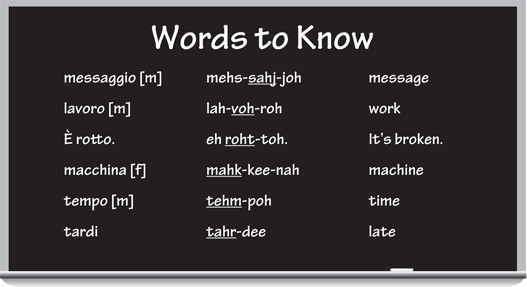Italian All-in-One For Dummies (44 page)
Read Italian All-in-One For Dummies Online
Authors: Consumer Dummies

Mr. Miller:
Ha ricevuto la mia raccomandata?
ah
ree-cheh-
vooh
-toh lah
mee
-ah rahk-koh-mahn-
dah
-tah?
Have you received the express letter I sent?
Sig. Tosi:
No, oggi non è arrivato niente.
noh,
ohj
-jee nohn eh ahr-ree-
vah
-toh
nyehn
-teh.
No, nothing has arrived yet today.
Mr. Miller:
Le mando subito un fax.
leh
mahn
-doh
sooh
-bee-toh oohn fahks.
I'll send you a fax immediately.
Sig. Tosi:
Purtroppo è rotto.
poohr-
trohp
-poh eh
roht
-toh.
Unfortunately, it's broken.
Mr. Miller:
Le invio un'e-mail allora.
leh een-
vee
-oh oohn-e
e-mail
ahl-
loh
-rah.
I'll send you an e-mail then.
Sig. Tosi:
Va bene. E può mandarmi il documento?
vah
beh
-neh. eh pwoh mahn-
dahr
-mee eel doh-kooh-
mehn
-toh?
Yes. And can you send me the document?
Mr. Miller:
Certo, glielo mando come allegato, ma avrò bisogno di più tempo.
chehr
-toh,
lyee
-loh
mahn
-doh
koh
-meh ahl-leh-
gah
-toh, mah ah-
vroh
bee-
zoh
-nyoh dee pyooh
tehm
-poh.
Of course, I'll send it as an attachment, but I'll need a bit more time.
Sig. Tosi:
Va benissimo. Oggi lavoro fino a tardi.
vah beh-
nees
-see-moh.
ohj
-jee lah-
voh
-roh
fee
-noh ah
tahr
-dee.
That's great. I'm working late today.
Â

Chapter 7
Food, Glorious Food, and Drink
In This Chapter
 Taking a look at breakfast, lunch, and dinner
Taking a look at breakfast, lunch, and dinner
 Surveying Italian drink selections
Surveying Italian drink selections
 Reserving a table and paying for your meal
Reserving a table and paying for your meal
 Going grocery shopping
Going grocery shopping
F
ood is distinctly unique from one region to another. This chapter introduces you to essential phrases to help you enjoy eating Italian-style.
Buon appetito!
(bwohn ahp-peh-
tee
-toh!) (
Enjoy!
)
Eating, Italian-Style
Italians have three main meals:
la prima colazione
(lah
pree
-mah koh-lah-
tsyoh
-neh) (
breakfast
),
il pranzo
(eel
prahn
-zoh) (
lunch
), and
la cena
(lah
cheh
-nah) (
dinner
). You eat
uno spuntino
(
ooh
-noh spoohn-
tee
-noh) (
a snack
) when you're hungry between main meals.
La merenda
(lah meh-
rehn
-dah) is a snack-time that most children enjoy daily.
Having breakfast
Your first meal of the day is always
la prima colazione
(lah
pree
-mah koh-lah-
tsyoh
-neh) (
breakfast
).
Some Italians begin the day with
un caffè
(oohn kahf-
feh
) (
espresso
) at home, but many stop for breakfast in
un bar
(oohn bahr) (
a coffee shop
) on their way to work. Breakfast consists of coffee and
una pasta
(
ooh
-nah
pahs
-tah) (
a pastry
), which can be
salata
(sah-
lah
-tah) (
savory
),
semplice
(
sehm
-plee-cheh) (
plain
), or filled with
marmellata
(mahr-mehl-
lah
-tah) (
jam
),
crema
(
kreh
-mah) (
custard
), or
cioccolato
(chohk-koh-
lah
-toh) (
chocolate
).
Talkin' the Talk
The man behind the counter in a coffee bar in Italy is called
il barista
(eel bah-
rees
-tah) (
the barman
).
Barista:
Buongiorno!
bwohn-
johr
-noh!
Good morning!
Sig. Zampieri:
Buongiorno! Un caffè e una pasta alla crema per favore.
bwohn-
johr
-noh! oohn kahf-
feh
eh
ooh
-nah
pah
-stah
ahl
-lah
kreh
-mah pehr fah-
voh
-reh.
Good morning! One espresso and a custard pastry please.
Barista:
Qualcos'altro?
qwahl
-kohs-
ahl
-troh?
Anything else?
Sig. Zampieri:
Una spremuta d'arancia, per favore.
ooh
-nah spreh-
mooh
-tah dah-
rahn
-chah, pehr fah-
voh
-reh.
One fresh-squeezed orange juice, please.
Barista:
Ecco la spremuta.
Prego.
ehk-
koh lah spreh-
mooh
-tah.
preh
-goh.
Here's the juice. Here you go.
Â
Eating lunch
Italians do
il pranzo
(eel
prahn
-zoh) (
lunch
) differently from many other countries. The traditional courses are
 antipasto
antipasto
(ahn-tee-
pah
-stoh) (
appetizer
): Can be either hot, such as
bruschetta
(brooh-
skeht
-tah) (
toasted bread
),
crostini
(kroh-
stee
-nee) (
croutons
),
and
supplì
(soohp-
plee
) (
rice croquettes
), or cold, such as
prosciutto e melone
(proh-
shooht
-toh eh meh-
loh
-neh) (
prosciutto and cantaloupe
) or
affettato e olive
(ahf-feht-
tah
-toh eh oh-
lee
-veh) (
cold cuts and olives
).
Antipasti
vary from region to region.
 primo piatto
primo piatto
(
pree
-moh
pyaht
-toh) (
first course
): Although this comes after the antipasto, it's still called a first course. The
primo
consists of all kinds of
pasta
(
pah
-stah) (
pasta
),
risotto
(ree-
zoht
-toh) (
risotto
), or
minestra
(mee-
nehs
-trah) (
soup
).
 il secondo
il secondo
(eel seh-
kohn
-doh) (
the second course
): This generally consists of
carne
(
kahr
-neh) (
meat
) or
pesce
(
peh
-sheh) (
fish
), prepared in a wide variety of ways.
 contorni
contorni
(kohn-
tohr
-nee) (
side dishes
): Vegetables may be ordered separately.
 il dolce
il dolce
(eel
dohl
-cheh) (
the dessert
): Last, but certainly not least, dessert may be
un dolce
(oohn
dohl
-cheh) (
a sweet
),
frutta fresca
(
froot
-tah
frehs
-kah) (
fresh fruit
), or
una
macedonia
(
ooh
-nah mah-cheh-
doh
-nyah) (
fruit salad
).
